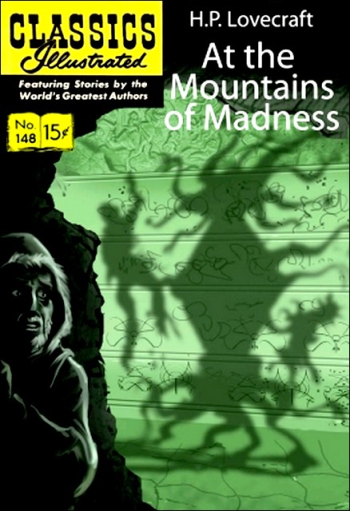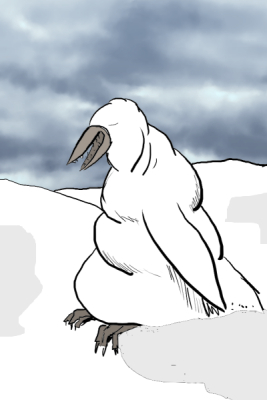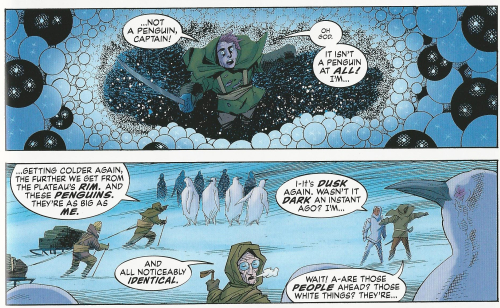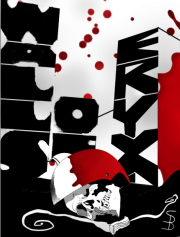
We Like Comics about H.P. Lovecraft Stories!

H.P. Lovecraft starved to death answering fan mail. He was pen-pals with Robert E. Howard, the guy who came up with the whole Conan the Barbarian Mythos. H.P. Lovecraft wrote fantasy short stories, horror stories, and novelettes, some of which pulled up concepts of an intelligent race older than humanity. Other stories took steps in the direction of the elder gods; concepts that the human mind was unable to comprehend without the choice of insanity.
New artists arise; old artists die, or stop working, and sometimes their works gain greater fame than the artists. This, I believe, is what happened. Very few people who aren't fans have heard of Lovecraft, who died 78 years before 2015. Yet if you do an image search on your phone for Cthulu and show people a gigantic humanoid with an octopoid head, bat wings, and tentacles where its mouth should be, they will invariably say "Oh yeah, I know what that is." Kinda like in the third century Rome when people would call up an image of a crucifix on their phones and show it to other people: "Oh yeah, I know what that is." The name of the writer is disappearing, but his works live on.
I believe comics are a great way to get acquainted with H.P. Lovecraft's work. He wrote in a time different from ours, where reading off of paper was one of the primary mediums next to music and the stage. Radio was only starting; Movies were about 20 years old. Television was only imaginary. 1920s America saw an increase in educated, literate Americans with disposable income, and magazine publishers took advantage of innovations in printing technologies to deliver monthly anthologies of printed works. This time in America's history is where we got the whole idea of genres from; Science Fiction, Fantasy, Romance, Action, all these ideas we use today to describe sections of the entertainment industry and the tastes of their fans came from this moment.
The good comics based on his work, I've found, take the reader into a new dimension. The Lovecraftian mythos invoked vivid imagery; as the patterns of American speech and written words change, the power and affect of Lovecraft's writing can get snowy like a receiver stuck between two different broadcast stations. H.P. Lovecraft comics remove all the fuzz, and clear up the sound, and enhance the resolution to the point of holography. You get darkness, and aloneness, in a way from comics that you don't get from the words. Below are some of the best comics about H.P. Lovecraft's short stories.
I. N. J. Culbard: The Dream Quest of Unknown Kadath and At the Mountains of Madness
I.N.J. Culbard did straight adaptations of these two stories. This stuff works because there's a line between taking everything from a book and sticking it in a comic, or making a good comic through thoughtful use of the source material. Also, these two books are in color, which really adds to the presentation. The first book Culbard did, "At the Mountains of Madness", is based on a work that discusses exploration of the South Pole. Technically, this was the time when the South Pole was terra incognita, and the heroic age of Antarctic exploration. There might have been King Kong or Godzilla running around down there for all anyone knew, so Lovecraft's Antarctica naturally had great tunnels and underground cities inhabited by things that lived long before man, or even before mammals. Several films have been made based on Mountains of Madness. A Youtubes search won't let you down.

Having the whole story in a comic allows it to be read in one or two sittings, and this can blow the mind of people who are unfamiliar with the concepts. A straight adaptation into a comic allows the reader to consider what Lovecraft was trying to convey. He was aware he'd be talking to large audiences. One of the really neat things in this story was the albino penguin-things. These are large, ugly, flightless birds that appear in the story. What's cool about it, and what's so horrible, is that it takes old concepts that swim in the mind of man, and twists them.
You're aware that birds have a symbolic aspect. We humans dwell on the ground, and birds are able to fly anywhere they want. In the human mind, and in the stories we share, birds have the character of being closer to God because they can fly up where God is. This characterization of birds appears in many of the old myths, go ahead and look. But with Lovecraft's penguins, they are flightless. They have no color. They are blind. These things dwell on the ground with us; some thinking will suggest their specific symbolic character, which can easily lead to nightmares.
Alan Moore: The Courtyard
This comic isn't taken from any particular Lovecraft stories. Instead, Alan Moore uses the Lovecraft mythos and combines it, in his particular manner, with facts from this world that you and I share. This is what makes this work so creepy; reading it is like getting your brain splashed with this glowing paint. What's real here? Is Alan Moore making this stuff up, or is he telling us about what happened? For weeks afterward, I wrestled with the conclusions of this work in my head.
With this comic, we see deeper into the underlying themes that Lovecraft used in his stories. Or at least, we get a good idea of what Alan Moore is seeing inside Lovecraft's stories. I don't know if Lovecraft's brain was some kind of boiling mess, or if he was just trying to make a living by writing stories people liked, but I think he understood that art combines with the existing knowledge in the reader's mind. Like the bird symbolism a few paragraphs ago, there's a bunch of non-verbal information in the human mind that we just sort of know by living in the culture that we do. For example, even though I bet no one reading this has seen or interacted with a demon, we know what demons are. Those of us who are so inclined can investigate this topic more thoroughly, but we know generally about demons even though we never took any courses in school or had deep conversations about them.
Alan Moore uses this concept well; it's what makes his stories so engaging. In The Courtyard, Alan Moore found a deep vein in the symbolism of Lovecraft's work that refers to themes of domination and intimacy and sex; the sexual act itself as well as associated themes like caring and pregnancy and progeny. Moore took that ball and ran with it downfield, slipping on gore, dodging curved, dripping blades, he ran that ball into the goal. This is a brutal comic; some readers may be tempted to stop reading at certain parts. Once you keep reading, you can't un-see it. Caution advised.
Alan Moore & Kevin O'Neil: Nemo: Heart of Ice
Alan Moore brings back the Lovecraftian mythos in his continuing series League of Extraordinary Gentlemen. He has one of his characters, the daughter of the famous Captain Nemo, visit the antarctic. In his style, Alan Moore messes with the order of temporal events as a function of the narrative.

And a fierce battle ensues, killing most of the crew. Too late, the crew learns that they aren't actually penguins after all. First they meet up with what seem to be tall, albino penguins after experiencing temporal distortions.
Moore's got his own thing going on with his characters and incorporates the Lovecraft beings into a larger comic story. The long swathes of text he writes at the end of each League book may go into more detail, but for some reason I find them hard to read & I've never got around to finishing them.
Sam Battin: Walls of Eryx
As it turns out, I've written a comic about one of H.P. Lovecraft's short stories too. This was a science fiction story he wrote with a fan of his. The fan later became a medical doctor. I liked how it was set on Venus. The first time I read it, when the main character decided to investigate the building, I remember thinking whoah that is a dangerous thing to do. The story held my attention from there. I kept finding new things to add as I built out the story I saw in my head. Also I revised the dialog, updated it basically so it would fit better in the panels and resonate with an early 21st century audience. You'll get a surprise if you compare the text of the book with the comic and I'd be happy to explain it. Available for only 99 cents from Comixology!

